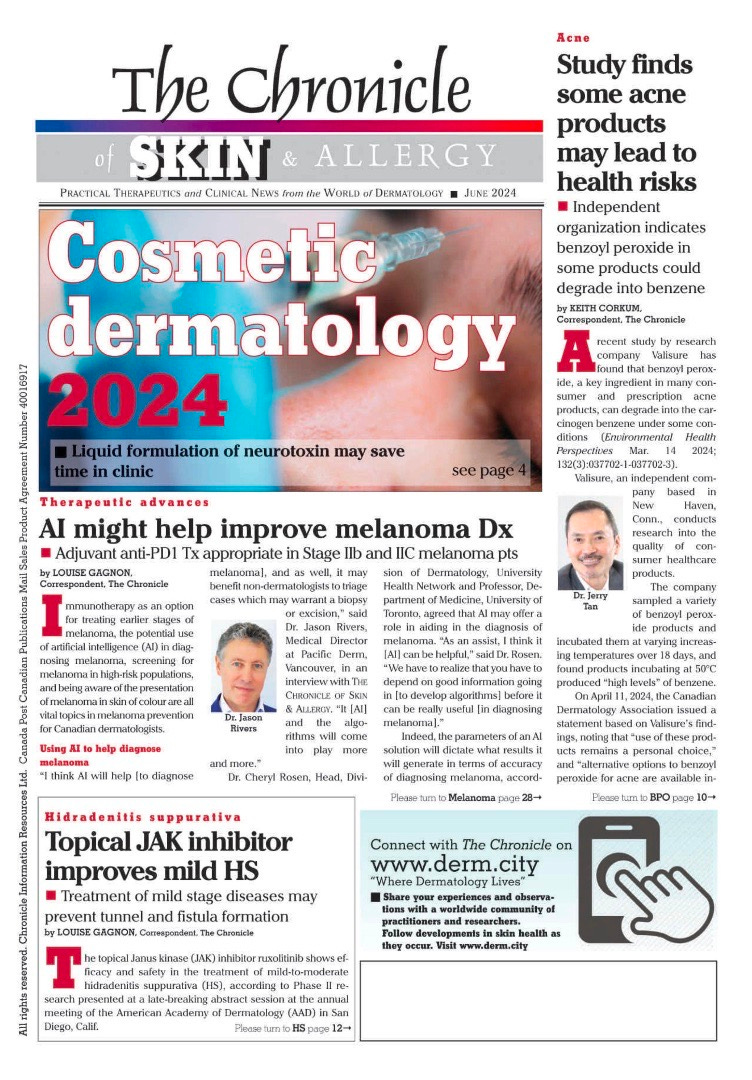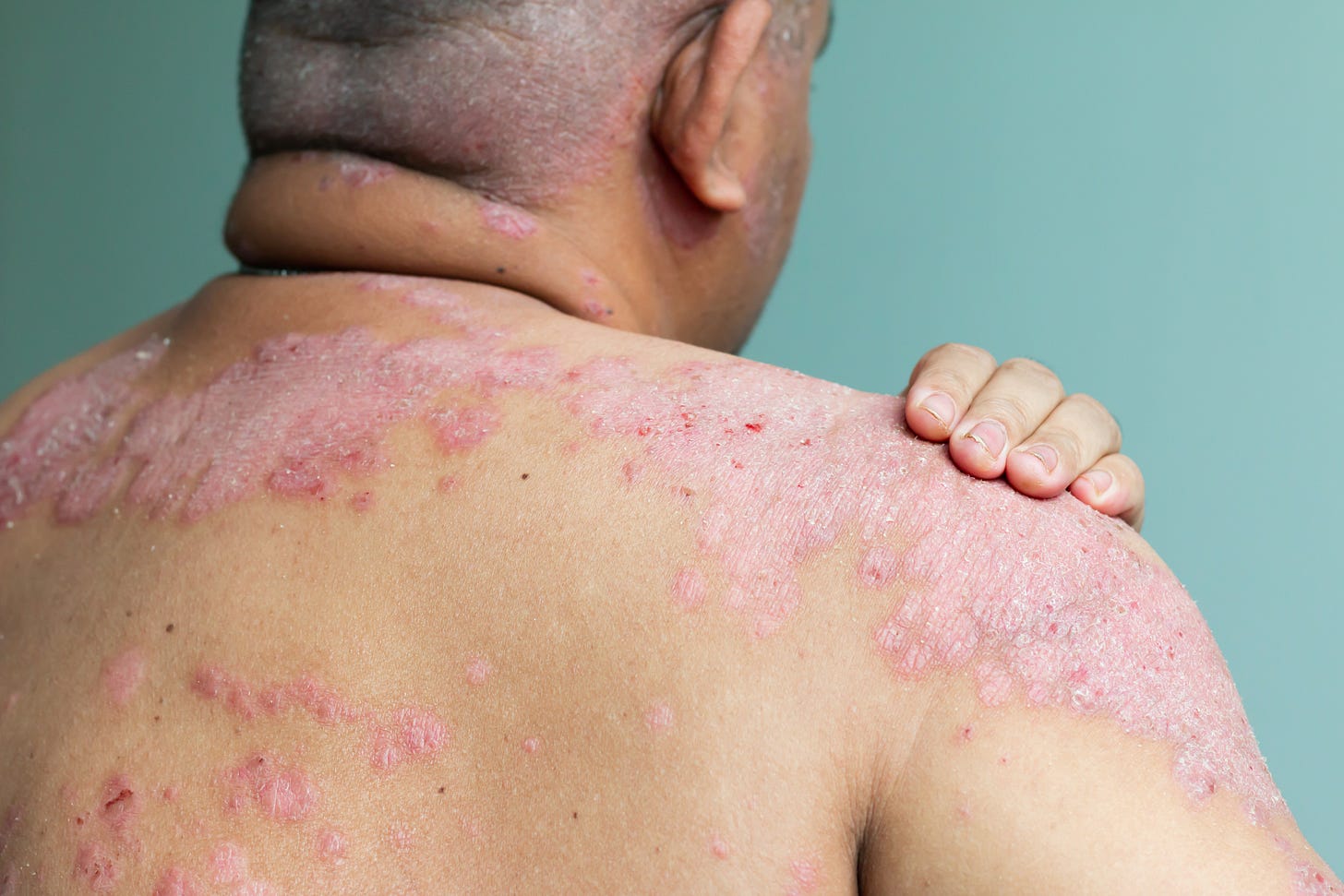Switching related to inefficacy in biologics and targeted synthetic therapies for PsA
Today's report also covers psoriatic arthritis in cohorts with arthralgia, biologic treatment sequences, and more (1,650 words, 6 minutes, 45 seconds)
The Vender on Psoriasis e-newsletter is supported by an unrestricted grant from Sun Pharma Canada
Good morning and welcome to the sixteenth issue of Special Reports: Skin Spectrum Weekly presents “Vender on Psoriasis.” This series is based on Dr. Vender’s popular column appearing in each edition of The Chronicle of Skin & Allergy, which offers expert commentary and opinions on current clinical developments in PsO. We’d love to get your feedback and suggestions and invite you to be in touch. Please write to us at health@chronicle.org

Switching related to inefficacy in biologics and targeted synthetic therapies for PsA
This retrospective observational study (Therapeutic Advances in Musculoskeletal Disease) examined switching between biologic and targeted synthetic disease-modifying antirheumatic drugs (b/tsDMARDs) due to inefficacy in patients with psoriatic arthritis (PsA). The study included 141 PsA patients treated with b/tsDMARDs at a rheumatology outpatient clinic in Madrid from 2007 to 2022.
A total of 56 patients (40%) experienced 121 switches between b/tsDMARDs, with 103 switches due to inefficacy. The researchers found that:
· The incidence rate of switching due to inefficacy was 11.53 per 100 patient-years.
· 20% switched due to inefficacy in the first year, increasing to 32% by the second year. Median drug survival was almost five years.
· In bivariate analysis, all b/tsDMARDs had higher risk of switching compared to TNF inhibitors. However, this was no longer significant in multivariate analysis after adjusting for confounders.
The researchers noted that factors associated with increased risk of switching due to inefficacy in multivariate analysis included: female sex, calendar time (increased risk from 2019 onward), presence of inflammatory back pain; concomitant use of glucocorticoids or sulfasalazine; and higher number of previous b/tsDMARD courses.
According to the study, TNF inhibitors and IL-17 inhibitors showed similar efficacy in real-world use.
The authors conclude that switching between b/tsDMARDs is common over time in PsA patients, with inefficacy being the primary reason. They found no significant differences in switching risk between different b/tsDMARD groups after adjusting for confounders. Clinical factors such as inflammatory back pain, female sex, and number of previous treatments were stronger predictors of switching than the specific b/tsDMARD used.
The study provides valuable real-world data on long-term b/tsDMARD use and switching patterns in PsA. Limitations of the study include the retrospective design and lack of standardized disease activity measures. Strengths include the long follow-up period and ability to adjust for multiple confounders. The findings may help guide treatment decisions and expectations regarding b/tsDMARD efficacy and durability in clinical practice.
Comment: A study published in Therapeutic Advances in Musculoskeletal Disease (2024) examined switching between b/tsDMARDs in psoriatic arthritis (PsA) patients due to inefficacy. Among 141 patients, 40% switched treatments, with inefficacy being the main reason. The risk of switching was higher in the first two years, with factors like female sex, inflammatory back pain, and prior treatments increasing the likelihood. TNF inhibitors showed similar efficacy to IL-17 inhibitors. The study provides real-world insights into the long-term use of b/tsDMARDs in PsA, although limitations such as its retrospective design and lack of standardized disease activity measures were noted. These findings could help inform treatment decisions and expectations for b/tsDMARD efficacy and durability in clinical settings.

Risk of developing psoriatic arthritis in psoriasis cohorts with arthralgia: Exploring the subclinical psoriatic arthritis stage
In a study published in RMD Open (2024; 10:e004314), researchers shed new light on the progression from psoriasis (PsO) to psoriatic arthritis (PsA), focusing on the critical “subclinical PsA” stage. This research provides valuable insights for clinicians aiming to identify and potentially prevent PsA in at-risk patients.
The study analyzed data from two cohorts totaling 384 patients with PsO, followed for an average of 33 months. Of these, 311 patients (80.9%) were classified as having subclinical PsA, primarily due to the presence of arthralgia.
The findings reveal a significantly higher risk of PsA development in the subclinical PsA group compared to those with PsO alone (HR=11.7, 95% CI 1.57 to 86.7, p=0.016). The cumulative incidence function (CIF) estimated the probability of new-onset PsA in subclinical PsA patients at 9.4% (95% CI 4.7% to 10.6%) at 12 months and 22.7% (95% CI 17.2% to 28.6%) at 36 months.
Notably, the study characterized the musculoskeletal (MSK) symptoms preceding PsA diagnosis. While 58.9% of cases reported inflammatory symptoms immediately before PsA onset, a surprising 83.9% had experienced non-inflammatory symptoms earlier. The researchers identified three distinct patterns of symptom progression:
1. Inflammatory pattern (16.1% of patients): Mean duration of 1.9 months before PsA diagnosis.
2. Non-inflammatory pattern (41.1%): Prolonged symptom duration, averaging 57.2 months before diagnosis.
3. Mixed pattern (42.8%): Initial non-inflammatory symptoms (mean 22.8 months) followed by inflammatory symptoms (mean 3.9 months).
The dominant clinical presentation of new-onset PsA was peripheral joint swelling (82.1%), with oligoarthritis being particularly common. This aligns with previous studies on early PsA, which have reported mean active joint counts between 1 and 3.
Interestingly, the frequency of dactylitis at PsA diagnosis (3.6%) was notably lower than in early PsA inception cohorts, where it’s typically observed in 40 to 50% of patients. This discrepancy likely reflects the low disease activity in the study's new-onset PsA cases.
The researchers emphasize the importance of characterizing arthralgia in terms of pain type, affected sites, and symptom duration to optimize therapeutic targeting of subclinical PsA. They also note the challenge in understanding symptomatology in this phase, given the substantial number of patients reporting non-inflammatory MSK pain before PsA onset.
While the study has limitations, including heterogeneous imaging data and retrospective collection of pre-PsA symptoms, it provides crucial insights into the subclinical phases of PsA. The findings underscore the need for vigilant monitoring of emergent MSK symptoms in patients with PsO, particularly those with arthralgia, to facilitate early detection and potential prevention of PsA.
This research marks a significant step forward in understanding the transition from PsO to PsA, offering clinicians valuable guidance for identifying patients at high risk of PsA development and potentially intervening before the onset of clinical disease.
Comment: This study marks a significant step forward in understanding the transition from PsO to PsA. It provides clinicians with crucial insights into the subclinical phases of PsA, emphasizing the need for detailed symptom characterization and vigilant monitoring of at-risk patients. By identifying high-risk individuals early, clinicians can potentially intervene before the onset of clinical disease, improving outcomes for patients with psoriasis and preventing the debilitating effects of PsA.
The findings of this research should prompt dermatologists and rheumatologists to adopt a proactive approach in managing psoriasis patients, focusing on early detection and individualized treatment strategies. As our understanding of subclinical PsA evolves, it is hoped that these insights will lead to more effective prevention and management of PsA, ultimately enhancing the quality of life for patients with psoriasis.

Biologic treatment sequences in moderate-to-severe psoriasis
This retrospective study examined biologic treatment sequences in moderate-to-severe psoriasis across two tertiary centers in Australia from 2006 to 2020 (Australas J Dermatol). The researchers analyzed 440 treatment courses from 263 patients, investigating patterns of biologic switching, reasons for switching, and treatment efficacy.
Ustekinumab and adalimumab were the most frequently prescribed first-line biologics overall. However, after 2015, there was a shift toward increased use of IL-12/23 and IL-17 inhibitors as first-line treatments. TNF-α inhibitors showed the highest rate of switching (63.8%), while IL-23 inhibitors had the lowest attrition rates.
The study revealed that patients who did not switch biologics had lower BMI (mean 29.8 vs. 32.7) and lower rates of psoriatic arthritis (24.4% vs. 47.7%) compared to those who switched. The median PASI score at discontinuation generally exceeded 3.0, while it was below 1.2 for patients continuing treatment, suggesting these as potential thresholds for considering biologic switches.
IL-17 inhibitors demonstrated the most rapid treatment response, achieving PASI-90 and PASI-100 faster than other biologic classes. Biologic-experienced patients on IL-17 inhibitors who continued treatment had the lowest median absolute PASI of 0.0.
The main reasons for switching biologics were loss of efficacy (36.0%) and lack of efficacy (31.4%). Patients with higher BMI were more likely to switch due to efficacy issues or psoriatic arthritis flares. Adverse events were most common with TNF-α inhibitors.
This study provides valuable insights into real-world biologic treatment patterns in Australia, highlighting the increasing use of newer biologics like IL-17 and IL-23 inhibitors due to their rapid onset of action and efficacy. It also identifies factors associated with biologic switching, such as BMI and psoriatic arthritis, which can guide clinical decision-making.
Limitations include the small sample size, limited data on newer biologics, and potential variability in switching practices. The authors suggest that larger-scale, long-term studies are needed to further elucidate optimal treatment sequencing for clinical guidelines.
Comment: This retrospective study provides valuable insights into biologic treatment patterns for moderate-to-severe psoriasis in Australia from 2006 to 2020. It highlights a shift toward using IL-17 and IL-23 inhibitors as first-line treatments due to their rapid efficacy and lower switching rates compared to TNF-α inhibitors. The study also found that patients who did not switch biologics had lower BMI and less psoriatic arthritis, indicating these factors may predict better treatment outcomes.
IL-17 inhibitors stood out for their quick achievement of PASI-90 and PASI-100 and sustained low PASI scores in biologic-experienced patients. The main reasons for switching biologics were loss or lack of efficacy, particularly among patients with higher BMI or psoriatic arthritis.
While the study offers important real-world data, its limitations—such as the small sample size and limited data on newer biologics—highlight the need for further large-scale studies to refine treatment sequencing and improve clinical guidelines.

If you find the contents of this newsletter interesting, please check out the Vender on Psoriasis podcast. It’s available at Apple iTunes, Stitcher, Spotify, or wherever you get your podcasts.
Dr. Ron Vender is a Hamilton-based certified dermatologist with over 30 years of clinical practice experience and over 100 clinical trials in psoriasis. He is founder and director of Dermatrials Research Incorporated and Venderm Consulting, specializing in treatments and management solutions for individuals with psoriasis.
Subscribe to The Chronicle of Skin & Allergy
Established in 1995, The Chronicle of Skin & Allergy is a scientific newspaper providing news and information on practical therapeutics and clinical progress in dermatologic medicine.
To apply for a complimentary* subscription, please email health@chronicle.org with your contact information or click the link below.






